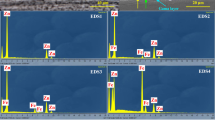Abstract
Most studies on corrosion of steel reinforcement in concrete are conducted on steel samples with polished surface (free of all oxides) in order to reproduce the same experimental conditions. However, before embedding in concrete, the steel bars are often covered with natural oxides (rust), which are formed during exposure to the atmosphere. The presence of this rust may affect the electrochemical behavior of steel rebar in concrete. In order to understand the effect of rust on the corrosion behavior of reinforcement steel, potentiodynamic and electrochemical impedance spectroscopy (EIS) tests were carried out in a simulated concrete pore solution using steel samples with two different surface conditions: polished and rusted samples. The obtained results have shown that the presence of rust on the steel bar has a negative effect on its corrosion behavior, with or without the presence of chlorides. This detrimental effect can be explained by the fact that the rust provokes a decrease of the electrolyte resistance at the metal-concrete interface and reduces the repassivating ability. In addition, the rust layer acts as a barrier against the hydroxyl ion diffusion, which prevents the realkalinization phenomenon.










Similar content being viewed by others
References
V. Feliu, G.A. Gonzalez, and S. Feliu: J. Appl. Electrochem., 2005, vol. 35, pp. 429–36.
O. Poupard, A. Aït-Mokhtar, and P. Dumargue: Cem. Concr. Res., 2004, vol. 34, pp. 91–1000.
G. Batis and E. Rakanta: Cem. Concr. Compos., 2005, vol. 27, pp. 269–75 .
F.G. da Silva and J.B. Liborio: Mater. Res., 2006, vol. 9, pp. 209–15.
B. Huet, V. L’hostis, F. Miserque, and H. Idrissi: Electrochim. Acta, 2005, vol. 51, pp. 172–80.
U. Angst, B. Elsener, C.K. Larsen, and O. Vennesland: J. Appl. Electrochem., 2010, vol. 40, pp. 561–73.
L. Dhouibi, Ph. Refait, E. Triki, and J. Génin: J. Mater. Sci., 2006, vol. 41, pp. 4928–36.
M. Saremi and E. Mahallati: Cem. Concr. Res., 2002, vol. 32, pp. 1915–21.
J. Bonastre, P. Garcés, F. Huerta, C. Quijada, L.G. Andión, and F. Cases: Corros. Sci., 2006, vol. 48, pp. 1122–36.
T. Henriques, A. Reguengos, L. Proença, E. Pereira, M. Rocha, M. Neto, and I. Fonseca: J. Appl. Electrochem., 2010, vol. 40, pp. 99–107.
N. Birbilis, K.M. Nairn, and M. Forsyth: Electrochim. Acta, 2004, vol. 49, pp. 4331–39.
W. Chen, D. Rong-Gui, Y. Chen-Qing, Z. Yan-Feng, and L. Chang-Jian: Electrochim. Acta, 2010, vol. 55, pp. 5677–82.
H. Tamura: Corros. Sci., 2008, vol. 50, pp. 1872–83.
M. Yamashita, H. Miyuki, Y. Matsuda, H. Nagano, and T. Misawa: Corros. Sci., 1994, vol. 36, pp. 283–99.
E. Zitrou, J. Nikolaou, P.E. Tsakiridis, and G.D. Papadimitriou: Constr. Build. Mater., 2007, vol. 21, pp. 1161–69.
A.J. Al-Tayyib, M. Shamin Khan, I.M. Allam, and A.I. Al-Mana: Cem. Concr. Res., 1990, vol. 20, pp. 955–60.
E. Proverbio and R. Cigna: Mater. Sci. Forum, 1995, pp. 877–82.
C.M. Hanson and B. Sorensen: “Corrosion Rates of Steel in Concrete,” ASTM STP 1065, ASTM, Philadelphia, PA, 1990.
J.A. González, J.M. Miranda, E. Otero, and S. Feliu: Corros. Sci., 2007, vol. 49, pp. 436–48.
L.T. Mammoliti, L.C. Brown, C.M. Hansson, and B.B. Hope: Cem. Concr. Res., 1996, vol. 26, pp. 545–50.
P. Novak, R. Mala, and L. Joska: Cem. Concr. Res., 2001, vol. 31, pp. 589–93.
M. Maslehuddin, M.M. Al-Zahrani, S.U. Al-Dulaijan, Abdulquddus, S. Rehman, and S.N. Ahsan: Cem. Concr. Compos., 2002, vol. 24, pp. 151–58.
J.A. González, A. Bautista, and S. Feliu: Cem. Concr. Res., 1996, vol. 6, pp. 501–11.
F. Zhang, J. Pan, and C. Lin: Corros. Sci., 2009, vol. 51, pp. 2130–38.
M. Keddam, H. Takenouti, X.R. Nóvoa, C. Andrade, and C. Alonso: Cem. Concr. Res., 1997, vol. 27, pp. 1191–1201.
D. Landolt: Corrosion et Chimie de Surfaces des Métaux, Presse Polytechniques et Universitaires Romandes, Lausanne, Switzerland, 2003.
Author information
Authors and Affiliations
Corresponding author
Additional information
Manuscript submitted December 9, 2012.
Rights and permissions
About this article
Cite this article
Bensabra, H., Azzouz, N. Study of Rust Effect on the Corrosion Behavior of Reinforcement Steel Using Impedance Spectroscopy. Metall Mater Trans A 44, 5703–5710 (2013). https://doi.org/10.1007/s11661-013-1915-4
Published:
Issue Date:
DOI: https://doi.org/10.1007/s11661-013-1915-4




